Stephen Morris's Blog, page 5
December 20, 2022
Amen=Ascension
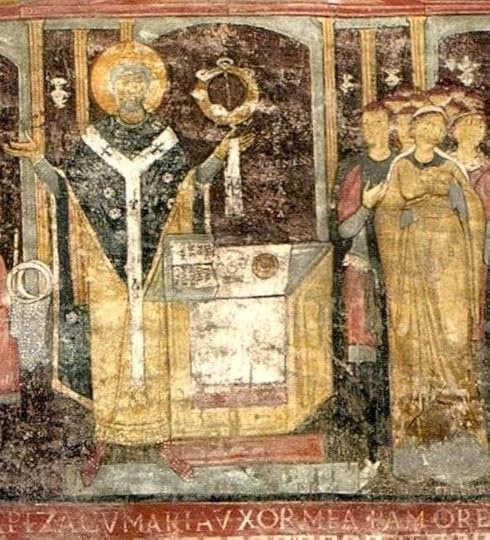 The people acclaim AMEN to the Eucharistic Prayer offered by St. Clement of Rome in this 8-11th century fresco in the 4th century Roman church dedicated to St. Clement, one of the first bishops of Rome. He wrote to the Corinthians, just as St. Paul had, urging them to maintain their fellowship with the bishop and the clergy appointed by him.
The people acclaim AMEN to the Eucharistic Prayer offered by St. Clement of Rome in this 8-11th century fresco in the 4th century Roman church dedicated to St. Clement, one of the first bishops of Rome. He wrote to the Corinthians, just as St. Paul had, urging them to maintain their fellowship with the bishop and the clergy appointed by him.For the Son of God, Jesus Christ, whom we preached among you … was not Yes and No; but in him is always Yes. For all the promises of God find their Yes in him. That is why we utter the Amen through him, to the glory of God. (2 Cor. 1:19-20)
Christ is the fulfilment, the “YES!” to every promise the Father has made. Christ is the realization of everything Israel hoped for in the Old Testament. Because Christ is the Father’s YES to us, we can–in Christ–say yes (AMEN) to the Father.
Paul’s preaching promised many things. He talked about being raised to life again and of being taken up into heaven. He talked about incorruption and those great rewards which awaited them. These promises abide unchanging …. They are always coming true.
St. John Chrysostom, Homily 3 on II Corinthians
Amen is a word that people often seem to think means “the end” at church. I have heard readers add “Amen” to the conclusion of almost any text as a way to announce, “I have finished the reading.” But Amen does not mean, “I’m done;” Amen means, “Yes! I agree! You took the words right out of my mouth. I ratify and endorse everything you have said!”
That’s why we respond Amen to a prayer. We endorse what the pray-er has offered on our behalf, especially a priest who speaks on our behalf, on behalf of the whole Church and also speaks on God’s behalf to us: “We endorse what you have said over these Holy Gifts of bread and wine!” “We ratify what you have said and make those words our own words as well!” “Yes!”
AMEN is one of the most important words in the world, for it expresses the agreement of the Church to follow Christ in his ascension to his Father, to make this ascension the destiny of man. It is Christ’s gift to us, for only in him can we say Amen to God, or rather he himself is our Amen to God and the Church is an Amen to Christ. Upon this Amen the fate of the human race is decided. It reveals that the movement toward God has begun.
Fr. Alexander Schmemann, For the Life of the World
The AMEN to the Eucharistic Prayer, the anaphora, is the seal of the prayer in which we ascend to the Kingdom and give thanks for all that has been done, is being done, and will be done by the Holy Trinity on our behalf. To ratify that movement, that ascension, is the single most important thing we can ever do.
The post Amen=Ascension appeared first on Stephen Morris, author.
December 13, 2022
Partners in Ministry
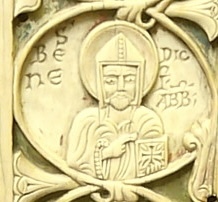 Veneto, 11th or 12th century
Veneto, 11th or 12th century Musée National de l’Age Médiévale, Paris
St. Benedict, identified by the inscription S[ANCTUS] BENEDICT[US] ABB[AS], “St. Benedict the Abbot.” His peaked cowl is like that seen on this saint in the 10th century fresco beneath San Crisogono in Trastevere, Rome, but with vertical and horizontal bands such as one would see on a bishop’s mitre. Benedict was not a bishop, but he is sometimes pictured in a mitre nevertheless, because a medieval abbot—and an abbess!—generally wore a mitre.
For we write you nothing but what you can read and understand; I hope you will understand fully, as you have understood in part, that you can be proud of us as we can be proud of you, on the day of the Lord Jesus. (2 Cor. 1:13-14)
St. Paul tells the Corinthians that he trusts them to understand what he is writing to them, just as they have understood what he has already taught them. He wants them to be proud of him as their spiritual father, just as he is proud of them as his spiritual children. After some of the things he said in First Corinthians, it sounds surprising that he says he is proud of them. But like any father, he is proud of his children despite their misunderstandings and problematic behavior.
Ambrosiaster, a Bible commentary writer in the AD 300s, said, “Paul asserts that his boasting over his disobedient children is noticed and that this will be to their advantage on the day of judgement.” On the day of the Lord Jesus, i.e. Judgement Day, Paul will boast of his Corinthian spiritual offspring and that will win them a favorable judgement from Christ. Paul’s pride in his spiritual children will overcome any doubts the Lord has about their suitability for his Kingdom.
Paul cuts at the root of the envy which his speech might occasion by making the Corinthians sharers and partners in the glory of his good works.
St. John Chrysostom (d. AD 407
But the apostle also says that he is not simply covering over their misbehavior with false pride. They share in his ministry by supporting him, listening to him, responding to him, correcting themselves based on his instructions. No one should be jealous that he is saying good things about them just because he wants to put on a face of false bravado.
They have understood his teaching in the past and he is confident they will understand his teaching now. True understanding involves a real response. The Corinthians didn’t just say, “Yes, yes” and then ignore what St. Paul had said. They might have disagreed or argued with him at first but when they understood his points, they responded by putting their understanding into action.
This correlation of understanding and action is at the heart of what St. Benedict wrote in his six-century Rule. A true monk — i.e. a real Christian — listens to his teacher and that listening involves action in response. “Listening” is not a passive activity; sound waves don’t enter your ears and then get forgotten. Listening is a very active process, in which the monk — or lay Christian in the world — hears the teaching, chews on it, mulls it over, and then integrates the teaching into his/her behavior.
Many times in the Psalms this point is also made: to hear is to act (Ps. 40, 45, 85). Jesus makes the same point: he listens to the Father and his listening results in his obedient action. Truly listening, the speaker and the hearer each want the same thing, they have one will. Authentic fellowship, i.e. communion, results.
The post Partners in Ministry appeared first on Stephen Morris, author.
December 7, 2022
God of All Comfort
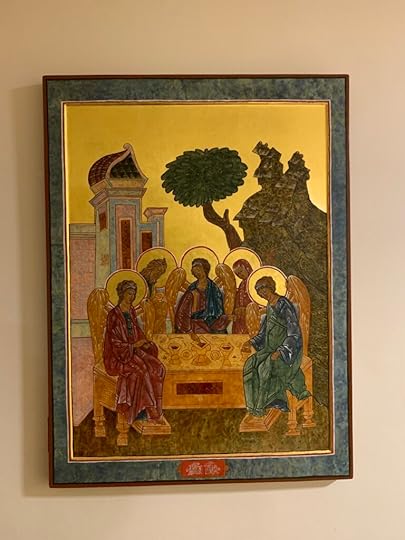 This icon at St. Paul’s K Street in Washington DC shows the Holy Trinity visiting Abraham and Sarah in the Old Testament. It reveals the Kingdom of God as the life of the divine community shared with humans by the Holy Spirit. During the Middle Ages, when people did not receive Holy Communion frequently, they said, “Thy kingdom-thy Spirit-come!” as the equivalent of sharing the divine life through the reception of Holy Communion.
This icon at St. Paul’s K Street in Washington DC shows the Holy Trinity visiting Abraham and Sarah in the Old Testament. It reveals the Kingdom of God as the life of the divine community shared with humans by the Holy Spirit. During the Middle Ages, when people did not receive Holy Communion frequently, they said, “Thy kingdom-thy Spirit-come!” as the equivalent of sharing the divine life through the reception of Holy Communion.Blessed be the God and Father of our Lord Jesus Christ, the Father of mercies and God of all comfort, who comforts us in all our affliction, so that we may be able to comfort those who are in any affliction, with the comfort with which we ourselves are comforted by God. (2 Cor. 1:3-4)
St. Paul writes his second epistle to the Corinthian church about a year after he wrote 1 Corinthians. Some people think II Corinthians is actually parts of two letters put together. We know that the parish in Corinth kept having problems for a long time … St. Clement, one of the early bishops of Rome, wrote letters to the parish in Corinth because they were still having problems in AD 95!
St. Paul begins by blessing God the Father who comforts the Church. Nowadays “comfort” means “feel good” but the Father did not send his Son to make us feel good. “Comfort” used to mean “strengthen” or “make strong.” It means “to be strong with.” The Father gives his Son to make us strong to face affliction and to share this strength with others who are facing various afflictions.
This comfort–strength–is given us by the Holy Spirit. Many times the great preachers and teachers of the past identify the presence of the Holy Spirit with the Kingdom of God; to pray “thy Kingdom come” is asking for the Holy Spirit to come and dwell within us and among us. St. Gregory of Nyssa wrote:
But what does it mean to say that the kingdom of God is within us? It can only mean the gladness which comes from on high to souls through the Spirit! It is like an image and a deposit and a pattern of everlasting grace which the saints enjoy in the time to come. So the Lord summons us through the activity of the Spirit to salvation through our afflictions and to sharing in the goods of the Spirit and his own graces.
St. Gregory of Nyssa, On the Christian Way of Life
The Father shares the Spirit to us now so that we can begin to experience a little bit of what eternity is like. We are called to experience the gift–the presence–of the Holy Spirit not as the absence of affliction but as we are experiencing affliction. The presence of the Holy Spirit –Kingdom of God–is not to make us feel good but to enable us to already experience a little of what we will experience in eternity.
Afflictions are our chance to experience the victory of Christ now. Afflictions are the opportunity we have to know that God truly stands with us, no matter what. Afflictions are our chance to share the Good News with others, not by preaching and lecturing but by holding the hand of someone in pain and being strong together with them.
“Thy kingdom come!” The kingdom–the Spirit–is given to us to share, not to hoard for ourselves. The kingdom-Spirit-gospel-comfort is primarily a SOCIAL experience that God is WITH us here and now rather than an individualistic experience of “salvation.”
The post God of All Comfort appeared first on Stephen Morris, author.
November 28, 2022
Maranatha!
 Christ, vested as a medieval bishop, distributes the Holy Communion to the apostles: on one side, St. Peter leads six others to receive the Holy Bread while St. Paul, on the other side, leads five others to receive from the Holy Cup. In the Didache, the celebrant invites the faithful to Holy Communion: “Let grace come and this world pass away.” The faithful answer: “Maranatha!”
Christ, vested as a medieval bishop, distributes the Holy Communion to the apostles: on one side, St. Peter leads six others to receive the Holy Bread while St. Paul, on the other side, leads five others to receive from the Holy Cup. In the Didache, the celebrant invites the faithful to Holy Communion: “Let grace come and this world pass away.” The faithful answer: “Maranatha!”If anyone does not love the Lord, let him be anathema. Maranatha! The grace of the Lord Jesus be with you. My love for all of you in Christ Jesus. (1 Cor. 16:22-24)
These sentences are part of the postscript, the “P.S.” that St. Paul adds in his own handwriting at the end of this first letter to the parish in Corinth. “Anathema” is “cursed” and is the same word the ecumenical councils use when denouncing the teachings that were condemned: “If anyone teaches that the Word is not divine in the same way the Father is divine, let that person be anathema!” Anathema marks those who are excluded from the fellowship of the Church, the Body of Christ.
Although St. Paul had difficult and challenging things to say to the Corinthians, he repeatedly stresses his love for them and that he does not want any one of them to be lost or cast aside. His love for the Corinthians–as a parish community and for each of them personally–is always his prime motivation.
“Maranatha!” can be translated several ways, which is why many translations today leave it untranslated. It can mean, “Come, our Lord!” Or it can mean, “Our Lord comes!” Both meanings are appropriate and maybe St. Paul meant the Corinthians to hear both meanings at the same time. Liturgical practice–described in the Didache— from about the same time that St. Paul was writing these words used “Maranatha!” as the people’s response to the invitation to receive Holy Communion at the Eucharist.
By this one word–Maranatha!–Paul strikes fear into them all. But not only that: he points out the way of virtue. As our love for God’s coming intensifies, there is no kind of sin which is not wiped out.
St. John Chrysostom (4th century), Homily 44 on 1st Corinthians
St. Paul expected his letter to be read at the Eucharist so his comments about the holy kiss and “Maranatha” are also connections to what the parish is about to do: pray together, exchange the Kiss, give thanks, and receive Holy Communion.
“Maranatha!” indeed.
The post Maranatha! appeared first on Stephen Morris, author.
November 21, 2022
Priscilla & Aquila Greet You
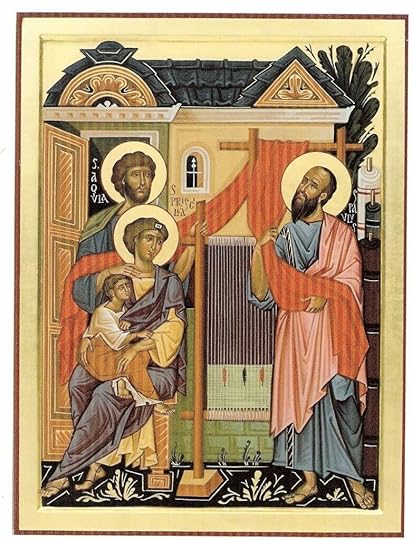 This icon shows SS. Paul, Priscilla, and Aquila working together as tentmakers and leatherworkers. Apollos is depicted as a child on Priscilla’s lap because she taught him everything he knew about the Faith (Acts 18, Romans 16).
This icon shows SS. Paul, Priscilla, and Aquila working together as tentmakers and leatherworkers. Apollos is depicted as a child on Priscilla’s lap because she taught him everything he knew about the Faith (Acts 18, Romans 16).The churches of Asia greet you. Aquila and Priscilla, together with the church in their house, send you warm greetings in the Lord. All the brothers and sisters greet you. Greet one another with a holy kiss. (1 Cor. 16:19-20)
Most letters in AD 1st century closed with a series of greetings. Almost all the epistles of the New Testament close with a series of greetings to those among whom the letter was read. The greetings at the end of 1 Corinthians are the most complex series of greetings at the end of any of St. Paul’s letters. St. Paul greets various people personally and sends greetings from various communities, such as “the churches of Asia” and the parish which meets in the house of Priscilla and Aquila.
Priscilla and Aquila are mentioned several times in the New Testament, in the Acts of the Apostles and in St. Paul’s letters. They were a Jewish-Christian couple and two of the first Christians in the capital city of Rome. When the emperor Claudius expelled the Jews form Rome because of the unrest and riots about Christ, Priscilla and Aquila went to Corinth. Then they moved to Ephesus and lived there, allowing a parish to meet in their home. After Ephesus, they were able to move back to Rome and hosted another parish in their home.
Priscilla is almost always mentioned before her husband, Aquila. This suggests that she was the more socially prominent member of the couple and that her family was more prominent than Aquila’s; yet he does not seem jealous of her prominence. She is often mentioned by early Christians as the probable author of “the Epistle to the Hebrews.” (The other possible author, Apollos, had been her student; she taught Apollos “everything he knew” about Christianity, according to St. Paul. Either way, she was–directly or indirectly–responsible for Hebrews.)
The “holy kiss” exchanged among Christians at the Eucharist was a scandal because people were not supposed to kiss anyone who was not a relative. Rumors of Christians kissing each other made non-Christians think incest and adultery were common Christian practices.
SS. Priscilla and Aquila hosted the Eucharist in their home. During the Eucharist, strangers–or at least, non-relatives–kissed each other. Priscilla and Aquila most have been known for allowing such scandalous and provocative behavior in their home; neighbors probably thought they were encouraging loose morals and sexual immorality and were hosting orgies on a regular basis.
Priscilla taught men the Faith. She and Aquila hosted strangers who kissed each other. Both activities were scandalous. Yet she and Aquila bravely persevered, working with St. Paul to spread and nurture the Church. They remain among the most important people of 1st-generation Christians. Through their teaching and leadership, they—especially Priscilla—have shaped a large part of what we now consider mainstream Christianity.
See my video discussion of St. Priscilla here. be sure to use the password: 3s=c03I=
The post Priscilla & Aquila Greet You appeared first on Stephen Morris, author.
November 14, 2022
Offering = Fellowship with the Saints
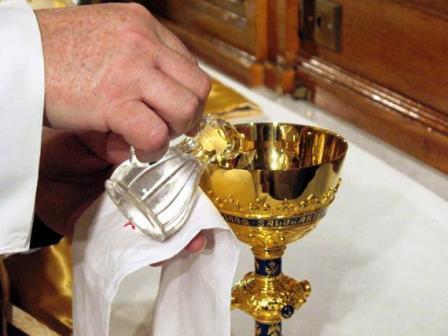
 Everyone was expected to bring something to offer at the Eucharist, even if it was only the clean water to be mixed with the chalice. No one expected to receive a portion of the Holy Gifts in Communion if they had not first offered something themselves, no matter how humble. The offering of bread, known as “prosphora,” are an expression of fellowship with the saints on earth as well as the saints in heaven.
Everyone was expected to bring something to offer at the Eucharist, even if it was only the clean water to be mixed with the chalice. No one expected to receive a portion of the Holy Gifts in Communion if they had not first offered something themselves, no matter how humble. The offering of bread, known as “prosphora,” are an expression of fellowship with the saints on earth as well as the saints in heaven.Concerning the collection for the saints, as I have ordered the churches of Galatia, so you should do likewise. On the first day of the week let each one of you put aside whatever he or she has gained, so that the collection doesn’t take place when I come. (1 Cor. 16:1-2)
Among the early Christians, there was no modern plumbing in the churches. No one could turn on a faucet to fill a cruet with water. If water was needed—and it was needed to mix with the wine in the chalice—then someone had to bring it to church from a well or a fountain. And among the early Christians, everyone was expected to bring something to offer at the Eucharist: most people probably would not bring cash but they could bring food or clothing to share with the poor. They brought the bread and wine to be placed on the altar. In Rome, orphans–who had nothing and were themselves the recipients of charity–brought the clean water to mix with the chalice for Holy Communion.
Taking a collection of some sort was standard practice at the Eucharist. Offerings (prosphora, in Greek) were a sign that the people making the offering had given themselves and their whole lives to God. The prosphora—food, clothes, money—collected for the saints was an important expression of fellowship, whether the people (“the saints”) receiving the prosphora were local or far away. Making an offering—bringing prosphora—to the Eucharist was an expression of fellowship with the needy saints on earth as well as with the glorious saints in heaven.
St. Paul is organizing a relief effort for the Christians in Jerusalem because there was a famine and severe need there. He is asking all the churches he has founded or visited to contribute to this collection. He will make sure the money gets delivered to Jerusalem, but he wants the local parishes to collect the money before he arrives so that he doesn’t have to wait for the collection itself to be made; he just wants to pick up the money they have already collected and send it on. He was afraid it would take too long if the local parishes waited to take up the collection and that it would arrive in Jerusalem too late.
St. Paul is organizing this relief effort for the Christian community in Jerusalem to demonstrate that he has no animosity or ill will for Christians who were not Gentiles. He is working to relieve the hunger and needs of the Jewish Christians who might have suspected that he thought Gentile Christians were better in God’s eyes than the Jewish Christians were. St. Paul wants to demonstrate that he does not think more highly of Gentile Christians and that all Christians are united in Christ.
St. Paul instructs the Christians in Corinth to organize the collection on Sundays, “the first day of every week,” at the celebration of the Eucharist. Many churches still call the bread brought to church for the Eucharist prosphora. The life of devotion to Christ and public service to the poor go hand-in-hand at the Eucharist. Fellowship with Christ cannot be divorced from fellowship with those in need.
The post Offering = Fellowship with the Saints appeared first on Stephen Morris, author.
October 31, 2022
O Hell, Where is Your Victory?
 Lamentation of Christ found in the Church of St. Panteleimon (Nerezi) in Macedonia. The fresco dates back to the 12th century. Several times hymns ask, “What place is capable of containing your life-bearing body?” Only the Church—and each Christian—can contain the life-bearing Body, received in Holy Communion, by which Christ incorporates us into his victory.
Lamentation of Christ found in the Church of St. Panteleimon (Nerezi) in Macedonia. The fresco dates back to the 12th century. Several times hymns ask, “What place is capable of containing your life-bearing body?” Only the Church—and each Christian—can contain the life-bearing Body, received in Holy Communion, by which Christ incorporates us into his victory.So when this corruptible body has put on incorruption, and this mortal body has put on immortality, then shall be brought to pass the saying that is written: Death is swallowed up in victory. O Death, where is your sting? O Hell, where is your victory? (1 Cor. 15:54-55)
St. Paul tells his readers that this mortal, corruptible body will become immortal and incorruptible when it is raised from the dead on the Last Day. That victory is already anticipated in Christ’s victory. St. Paul quotes three different verses from the Old Testament as if they were one passage, a common practice among ancient preachers–and modern ones!
Death is swallowed up in victory. (Isaiah 25:8)
O Death, where is your sting? O Hell, where is your victory? (Hosea 13:14)
There were several versions of these passages in circulation during the first century and most modern Bibles in English don’t have these exact versions in Isaiah and Hosea. But these are the passages most people are familiar with because of the way St. Paul used them and the way they appear in the famous Easter-Paschal homily of St. John Chrysostom:
[Hell] took a body and, face to face, met God! It took earth and encountered heaven! It took what it saw but crumbled before what it had not seen!
“O death, where is thy sting? O hades, where is thy victory?”
Christ is risen, and you are overthrown!
Christ is risen, and the demons are fallen!
Christ is risen, and the angels rejoice!
Christ is risen, and life reigns!
Christ is risen, and not one dead remains in a tomb!
Hosea 6:1-6 is traditionally read on Good Friday by Western Christians although most revisions of the services in the 1970s removed the reading from Hosea, which is unfortunate. Hosea’s reading on Good Friday and these words of his quoted at Easter express the traditional understanding that Christ’s victory begins on the Cross and will not be complete until the Last Day, when the entire human race is raised from the dead. Thus, Easter-Pascha is not the celebration of a past event; it is the celebration of an eschatological, apocalyptic event that began 2,000 years ago, is still happening, and will continue until time has ceased. It is an ongoing reality.
The post O Hell, Where is Your Victory? appeared first on Stephen Morris, author.
October 24, 2022
Second Adam
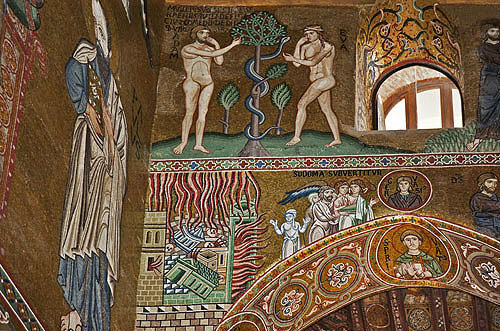 Mosaics in the Palatine Chapel, palace of the Norman kings of Sicily, built by Roger II, Palermo, Sicily, Italy (built in the AD 1100s). We see Adam & Eve with the serpent in the top row; below them the angels escort Lot and his family away from Sodom and Gomorrah. (Lot’s wife is the white statue of salt.) Read about artistic depictions of Eve and the serpent here.
Mosaics in the Palatine Chapel, palace of the Norman kings of Sicily, built by Roger II, Palermo, Sicily, Italy (built in the AD 1100s). We see Adam & Eve with the serpent in the top row; below them the angels escort Lot and his family away from Sodom and Gomorrah. (Lot’s wife is the white statue of salt.) Read about artistic depictions of Eve and the serpent here.It is written, “The first Adam was made into a living creature;” the last Adam is made into a life-giving spirit. But it is not the spiritual Adam that is first, but the natural; the second Adam is the spiritual. The first Adam is made of the dust of the earth; the second Adam is from heaven. (1 Cor. 15:45-46)
St. Paul refers to Genesis 2:7 (“Adam became a living creature”) to make his point that Christ, who is the Second Adam–the Ultimate Adam–is the model for human existence. The first Adam received life; the second Adam gives life. The first Adam (in Genesis) is made from the dust of the earth; the second Adam comes down to earth from heaven in order to raise the first Adam to heaven.
The first man was made from the slime of the earth. The second man came from heaven. By using the word MAN, he taught the birth of this person from the Virgin …. [was both human and] from the Holy Spirit who came upon the Virgin. Thus, precisely while he was human he was also from heaven.
St. Hilary of Poitiers, On the Holy Trinity, chapter 10.
Just as Christ was “the Second Adam,” his Mother is frequently referred to as “the Second Eve.” Justin Martyr wrote in AD 150
He became man by the Virgin, in order that the disobedience which proceeded from the serpent might receive its destruction in the same manner in which it derived its origin. For Eve, who was a virgin and undefiled, having conceived the word of the serpent, brought forth disobedience and death. But the Virgin Mary received faith and joy, when the angel Gabriel announced the good tidings to her that the Spirit of the Lord would come upon her, and the power of the Highest would overshadow her: wherefore also the Holy Thing begotten of her is the Son of God; and she replied, ‘Be it unto me according to thy word.” And by her has He been born, to whom we have proved so many scriptures refer, and by whom God destroys both the serpent and those angels and men who are like him; but works deliverance from death to those who repent of their wickedness and believe upon Him.
St. Justin Martyr, Dialogue with Trypho, chapter 100
It was also St. Irenaeus of Lyons who wrote in AD 182
In accordance with this design, Mary the Virgin is found obedient, saying: “Behold the handmaid of the Lord; be it unto me according to your word.” (Luke 1:38) But Eve was disobedient, for she did not obey when as yet she was a virgin. … having become disobedient, was made the cause of death, both to herself and to the entire human race; so also did Mary, having a man betrothed [to her], and being nevertheless a virgin, by yielding obedience, become the cause of salvation, both to herself and the whole human race.
And on this account does the law term a woman betrothed to a man, the wife of him who had betrothed her, although she was as yet a virgin; thus indicating the back-reference from Mary to Eve … For the Lord, having been born “the First-begotten of the dead,” (Revelation 1:5) and receiving into His bosom the ancient fathers, has regenerated them into the life of God, He having been made Himself the beginning of those that live, as Adam became the beginning of those who die. (1 Cor. 15:20-22)
Wherefore also Luke, commencing the genealogy with the Lord, carried it back to Adam, indicating that it was He who regenerated them into the Gospel of life, and not they Him. So it was that the knot of Eve’s disobedience was loosed by the obedience of Mary. For what the virgin Eve had bound fast through unbelief, this did the virgin Mary set free through faith.
St. Irenaeus of Lyons, Against Heresies, Book 3, chapter 22
Just as Adam and Eve were both necessary for the creation of the world, so Christ and his Most Pure Mother were both necessary for the salvation of the world. Just as we share in the dust of the first Adam, we now share the spirit and resurrection of the Second–Ultimate!–Adam who was able to be born because the Second–Ultimate!–Virgin made the right choice when given the opportunity to love or reject God.
The post Second Adam appeared first on Stephen Morris, author.
October 18, 2022
What Kind of Body?
 This wall painting from the Dura Europa synagogue in Syria depicts the raising of the dead from the dry bones, described in Ezekiel 37.
This wall painting from the Dura Europa synagogue in Syria depicts the raising of the dead from the dry bones, described in Ezekiel 37.But someone will say, “How can the dead be raised? What kind of body will they have?” You fool! What you yourself sow does not come to life unless it dies. As for what you sow, you do not sow the body that will be but only a naked seed, such as wheat or something else. (1 Cor. 15:35-37)
Greek thinkers were disgusted at the thought that a dead body would be raised by God. They taught that the soul was immortal and that at death, it was set free from the prison of the body. That’s why pre-Christians and non-Christians often cremated the dead: to destroy the jail that was the body and liberate the soul.
Jews, like the Apostle Paul, did not believe in the immortality of the soul. They taught that the dead would be raised, body and soul together. A person was not complete without both a body AND a soul. The body was not a prison that a soul was trapped in; a body was an essential aspect of human reality. Early Christians taught that a human body was an aspect of the image and likeness of God that the human race was created to be.
The body is not the obstacle that prevents us from entering the Kingdom of God but rather our willful wickedness.
St. John Chrysostom, Homily 41 on 1st Corinthians
But none of the Jewish or Christian thinkers thought the resurrected bodies would just be our natural bodies resuscitated. The resurrected body of a person would be different somehow from the natural body before death. But no one was sure how the body would be different.
Origen thought our bodies would all be round, like beach balls, because the sphere is the perfect shape. Others thought our bodies would all look as they did when we were 33 years old since that is the age Jesus was when he was raised from the dead. Others said that the resurrected body would be gloriously bright, like Jesus’ body at the Transfiguration.
The resurrected body was described as “spiritual.” This did not mean “immaterial” or “ethereal.” St. Paul always uses the word flesh to mean “fallen, sinful.” He uses the word spiritual to mean “godly, saved.” Our resurrected bodies will not be sinful but godly, permeated and saturated with the Spirit and glory of God. Just as Jesus had a spiritual body after the Resurrection that could eat and drink and that the apostles could touch, so our bodies will be touchable but able to walk through locked doors and appear or disappear from rooms.
Certain saints are able to display some of these qualities even before they die, working various miracles by the Spirit of God that is already saturating their bodies because they have been washed with the water of baptism, anointed with the holy chrism, and consumed the Body and Blood of Christ in Holy Communion. Which is also why their bodies (i.e. relics) are able to perform miracles after they die. Our bodies display characteristics of the resurrection even before being raised because they are already becoming spiritual, i.e. godly.
The post What Kind of Body? appeared first on Stephen Morris, author.
October 11, 2022
Baptism For The Dead?
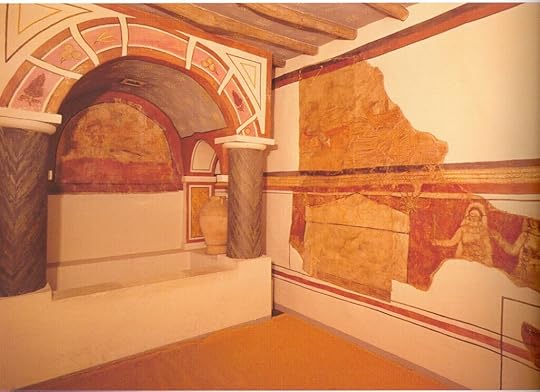 The earliest known indoor font and baptistery is from a house church located at Dura-Europos in modern-day Syria. It seems to have occupied an ordinary house that was converted for worship between AD 233 and 256.
The earliest known indoor font and baptistery is from a house church located at Dura-Europos in modern-day Syria. It seems to have occupied an ordinary house that was converted for worship between AD 233 and 256. The church was uncovered by a team of archaeologists during two excavation campaigns in the city from 1931-32. The frescos were removed after their discovery and are preserved at Yale University Art Gallery.
Otherwise, what do those who are baptized for the sake of the dead? If those who are really dead are not raised, why at all are they baptized for their sake? And why are we in danger at every hour? I die every day. (1 Cor. 15:29-30)
St. Paul refers to the living being baptized for the sake of the dead, a practice otherwise unknown in the early church. But it seems to be a practice that the Corinthians were familiar with. “Why be baptized for the dead if Christ is not raised from the dead?” The apostle refers to the liturgical practice of the Corinthians to underscore the point he has been making in the epistle: Christ was raised form the dead. Why else are we in church or doing anything as members of the Church? Nothing we do makes sense if Christ is not risen from the dead.
Sin has brought death into the world and we are baptized in the hope that our dead bodies will be raised again in the resurrection. If there is no resurrection, our baptism is meaningless and our bodies remain as dead as they are now.
St. John Chrysostom, Homilies on the Epistles to the Corinthians 40.2
The apostle might be referring to the baptism of those in bed and about to die or new-born infants about to die. Why baptize the dying and those as-good-as-dead if there is no Resurrection of the body?
But he seems to be referring not to deathbed baptisms but to people who are being baptized for vicariously for the deceased. People in the city of Corinth were generally concerned about the fate of the dead. Perhaps the living Corinthian Christians were baptized on behalf of their friends and neighbors–as well as their family members–who had not had the opportunity to become Christians during their lifetimes. If baptism was critical for sharing the Resurrection, how else could the living best serve the deceased?
Wherever the Gospel was preached, the new converts were always concerned about the fates of the non-Christian ancestors. Pagan Greeks came to see the poets and philosophers as the equivalent of the prophets in ancient Israel, so their ancestors had some access to the Good News just as ancient Jews did. In Gaul, it was common to bless pagan graves with holy water, baptizing the dead who were buried there. In other places, the prayers for the dead–especially on All Souls’ Day–were the most important prayers a new Christian could offer.
Prayers for the dead. Baptism on behalf of the dead. Blessing the pagan graves. These were all ways the living Christians showed their love and concern for their non-Christian dead relatives, trying to include the dead in the Kingdom of God. No one is ever saved alone. Salvation is, by definition, a communal event.
The post Baptism For The Dead? appeared first on Stephen Morris, author.



